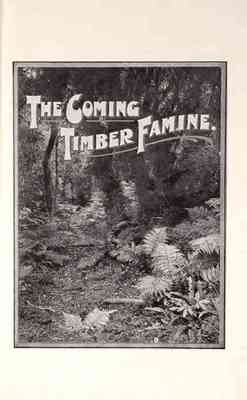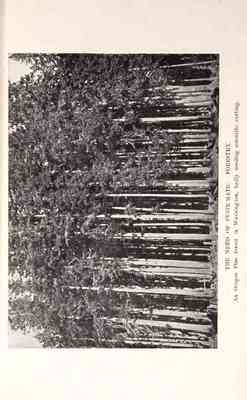Pages
[Illustration]
The Coming Timber Famine.
This page is blank
III.
THE COMING TIMBER FAMINE.
VERY few people have any conception of the enormous demands that are constantly made upon the world's available stock of timber, the extentto whcih the existing supplies are being annually diminished, and the extraordinarily serious consequences that must ensure if nothing is done in the near future to grappble with the emergency thus created. It is generally known in New Zealand that our kauri is within measurable distance of extinction, and that many of our most valuatible indigenous trees cannot long hold out against the constantly increasing demand. But even the people most directly interested in our sawmills or in the imprtation of Oregon pine do not seem to realise that the shortage in our timber output is mearely a single phase of a widespread falling off in the world's supply of timber, and that in no long period of time we will be unable to replenish our stock by importations from other countries except at a ruinous cost. "Will there be a timber famine?" asks Mr. J. H. Young in a recent issue of the "World's Work" (Eng. ed.), and this answer to this momentous question opens in the following ominous terms:--
FACTS AND FIGURES.
"The alarming rate at which the world's supply of timber is being depleted is causing the gravest anxiety to those who are interested in afforestation, and many authorities on timber-growing affirm that unless the State undertakes some scheme of sylviculture, the very existence of the many industries dependent upon our wood supply is bound to be seriously imperilled in the future." This warning is directed more particularly to the United Kingdom, but unfortunately it applies quite as emphatically to nearly every other country in the world. In one sense it is quite unnecessary to pile up huge masses of statistics to illustrate what must be a sufficiently obvious truth. For it is self-evident that the forest resources of the wrld are not illimitable, and that if they are continually being cut down without being replaced, the day must come sooner or later then the demand for timber will no longer find means to satisfy itself. This is, of course, a mere truism, but like many other truisms it is not sufficiently appreciated by people in general, and this must be my excuse for labouring a point that certainly needs very little corroborative testimony. However, it may help to drive the argument home if I add here a few figures bearing on this question of the diminution of th world's timber stock, quoted from an interesting article that appeared recently in the Melbourne "Age." "The world's timber supplies are rapidly diminishing, and in almost every country the circumstance is causing an apprehension bordering on consternation, for the demand for timber all the world over is steadily and speedily augmenting. It was estimated not long ago by an Afforestation Committee in Britain that if the present rate of consumption is maintianed the timber supplies of Europe and America will be exhausted in another twenty years. Britain annually imports 5,000,000,000 superficial feet of timber, and her consumption, according to the latest availbable returns, increased in 1906 by 633,000,000 feet. Germany has a wellorganised Forest Department, and onefourth of her area is under forest; nevertheless she imports nearly 3,000,000,000 superficial feet per year. France has one-fifth of her are under forest, and she employs 3000 officers in the work of timber conservation and reafforestation; yet France imports 738.000.000 feet
14
of timber annually. The greater sources of supply for these countries are Northern Europe, America, and to a small extent New Zealand. But the enormous pine forests of Northern Europe are now almost denuded. New Zealand has 30,000,000,000 feet of timber still available, but it is diminishing at the rate of 430,000,000 feet a year. And America, comparatively speaking, is no better off. Throughout the United States the total quantity of marketable timber in 1906, according to the departmental calcuations, was 2,000,000,000,000 superficial feet. But America has 21,000 sawmills at work, which are cutting the enormous quantity of 37,500,000,000 feet per annum. It is obvious, therefore, the "Age" concludes, "that the world's timber outlook is very serious, and a shortage of supplies within the next couple of decards appears to be inevitable."
THE COMING CRISIS.
"I may supplement these facts with a few fruther extracts from the article on "The Coming Timber Famine," by Mr. J. H. Young, to whcih I have already referred :-- "The tremendous straing upon Russia's timber forests has been, and still is, of such a vast nature that the country will not long be able to supply the wants of outsiders. Norway a few years hence will be almost equally crippled. Indiscreet cutting down of millions of tons of timber in years past, with little or no preparation for the future, is already telling a tale. . . . Twentry-five years hence at the presetn rates of cutting, the timber supply of the United States will cease. Britain alone receives £3,000,000 worth of timber annually from America, but the rapid increase in the population points to a not far distant day when it will be only able to supply us with a little more than half that amount. The once magnificent forests of the United States have been enormously reduced within the last few years, and as the demand for a considerable time has been 25,000,000 tons ahead of the natural supply, the process of extermination goes remorselessly on. . . .
Canada hitherto has materially helped to make good the deficit in America's timber supply; but here, again, the march of civilisation is making itself felt. The vasta nd ever-increasing population that has poured into Canada within the last few years has resulted in immense forests being cut down to make room for agriculture"' and in Canada, as well as throughour the United States, an everpresent and assiduous enemy is at work in the shape of the "devastating firefiend, the blighting irrepressible flames of which are responsible for the destruction of ten times more trees than those felled by the axe." It is true that before the timber famine actually becomes acute, the vast forests of Central and South America, of Central Africa, and North-Eastern Asia will be requisitioned, and will help to avert the evil day. But all this evidence tends emphatically to confirm the opiton already advanced that the world's supply of timber is no longer equal to the demand, and that unless existing conditions are radically aletered, a very few years will bring us all face to face with a mostserious crissi through the universal scarcity of one fo the indispensable necessaries of progress and civilisation.
WHAT IT MEANS TO US.
To realise what this coming tiber famine may mean to the world at large, we have only to consider the countless uses to which timber is now applied. "In almost every undertaking, great or small," Mr. J. H. Young reminds us, "timber plays a more or less conspicuous part, and for numerous industries it is quite impossible to supplant it with any other substance. Thousands of tons are swallowed up every year for pit-props in mines; railway sleepers constitute a demand that must run up a big bill per annum, not to mention the many other uses for which wood is absolutely essential in the equipment and working of railways; while everybody, of course, knows that for the building trades timber is the base of their existence." Among the many by-proudcts of the forests we
[Illustration]
THE NEED OF SYSTEMATIC FORESTY.
An Oregon Pine forest in Washington, badly needing scientific cutting.




